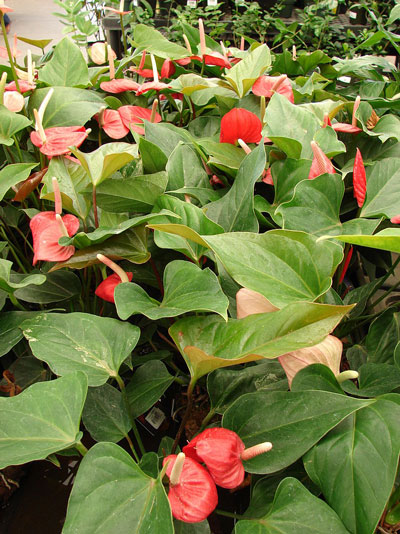Anthurium – Today it Is One of Hawaii’s Signature Flowers
Scientific Classification
| Kingdom: | Plantae |
| (unranked): | Angiosperms |
| (unranked): | Monocots |
| Order: | Alismatales |
| Family: | Araceae |
| Tribe: | Anthurieae |
| Genus: | Anthurium |
Anthurium is a variety consisting of around 1000 types of blossoming plants; Araceae is the biggest variety of the Arum group. Anthurium, flamingo, tail flower, and loose-leaf are the usual names by which people know them. This variety inhabits America and spreads along North Mexico to Northern Argentina and all along the Caribbean.
In 1889, British missionary Damon brought Anthuriums from Colombia through London to Hawaii. Today the Anthurium is one of Hawaii’s signature flowers.
Anatomy
Anthurium is a variety of herbaceous plants often growing as a non-parasite on other plants. Few grow on the ground and the leaves vary in shape and frequently group together. The flower comprises of a group of little flowers with a perfect combination of female and male structures. The thick spirals on the spadix accommodate the blooms. The spadix is generally lengthy and found shaped not only as spikes, but also in club and globe shape. Below the spadix we find the sheathing bract. This also varies in shape, but in most of the species, it takes a lance shape. It lengthens in the form a curve or it flattens out. Occasionally you find a form of a hood covering the spadix. The fruit grows on the spadix from the flowers. They vary in color and the berries are juicy with normally two seeds embedded in them.
How to Cultivate Domestically
Preparation for Planting

Photo by: Guilherme Jofili
Maintain your Anthurium in a warm temperature of 78° to 90°F at day. At night a temperature of 70-75°F is fine. For proper Anthurium flower care, permit, sufficient indirect light indoors. Keep your Anthurium plant away from direct sunlight. If the light is insufficient the growth of the plant becomes stunted and it may stop flowering. In case you see an Anthurium with stretching long leaves, it indicates insufficient light. Use a mild fertilizer solution thinned to ¼ of its strength. Indoor plant pests show an attraction to Anthurium; hence observe them carefully. In case you observe any pest, treat the plant immediately. Inspect the soil frequently to ensure proper drainage. The plant can easily contract diseases if the soil is humid; however a properly drained soil frees it from this problem.
Planting
Be certain that the soil round the Anthuriums has organic material and has a proper drainage. If required, mix one part perlite, one part peat moss and one part pine bark in a bucket and add it to the soil. Fill the prepared mixture with the soil in pots and plant your Anthurium in them. In the case of outdoor plants, remove the plant gently from the pot using a garden spade and put a 2-3 inch layer of the constituents into the base of the hole and plant your Anthurium into the hole and cover the roots with soil. Further place mulch to a thickness of two to three inches right round the bottom of your outdoor Anthurium plant; this mulch conserves moisture in the roots of the plant. Use a 3:1:2 liquid plant fertilizer monthly once for your red Anthurium.
Placement and Watering
Whether outdoor or indoors, keep your Anthurium plants in such a place where it can get sufficient indirect sunlight. Water your Anthurium to a minimum of weekly, twice or when you observe the top soil dry. Never allow your soil to completely dry since this will hurt the plant. Also, never permit the soil to soak in water, this is also dangerous to the plant.
Flowering Period
The blossoming period extends from spring to end of summer. It is a pity, that anthuriums do not grow easily except, that the most common ones tolerate the ordinary room condition to a certain limit.
After Bloom Care
Once blooming is over eliminate the withered flowers by shearing the whole stalk with a hand pruner at the bottom of the plant. Since Anthuriums do not rebloom on the same stalk, eliminating it transmits the plant’s energy into the newly growing stalks.
As Cut Flowers

Photo by: Forest & Kim Starr
Anthurium flowers stay on the plant for many weeks before fading away and dropping on the ground. As cut flowers, they live long, and lasts for four to six weeks, in water they last for around 45 days.

Having discovered a fondness for insects while pursuing her degree in Biology, Randi Jones was quite bugged to know that people usually dismissed these little creatures as “creepy-crawlies”.







